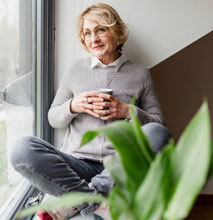Recognising and reducing anticipatory anxiety
 By Jayne Cox, Co-founder of Fusion Spaces
By Jayne Cox, Co-founder of Fusion Spaces
Have you ever been waiting for an appointment, meeting, or interview and felt as if you were unable to escape worrying thoughts playing in a loop in your mind? You may have found it difficult to regulate your body temperature, feeling hot and sweaty one minute and then cold and clammy the next. These are just some of the symptoms of a common form of future-focused anxiety, known as anticipatory anxiety.
Anticipatory anxiety, or the ability to focus our attention almost solely on worry and fear about what lies ahead, is an evolutionary response that we have retained as an effective form of defence.
And our reason for retaining it? This type of anxiety was effective at helping our primitive ancestors survive. Like them, any sign of an approaching threat which is seemingly beyond our control, will seize our attention in a way that is immediate and outside of our conscious awareness.
As modern-day humans we have large brains and the ability to be adaptable and adept at forming ideas. We can also create and solve problems; however, we can still suffer from these primitive forms of defence and survival.
The subconscious trigger for anticipatory anxiety was designed for times when the source of our threats where short-term. We would detect a threat and our attention would be temporarily diverted from anything else we may be doing to help us to live to see another day.
Today, it is far more complex as we find ourselves facing the future with so many potential cues of threat that the fight or flight response is triggered for long periods. As we have nothing to physically fight or escape, we may find ourselves feeling defenceless and moving in to freeze, or shutdown.
With nowhere left to run and nothing to fight we may find ourselves caught in the freeze state. In this state, our bodies can sense the increasing danger and pull the plug. Freezing when we need to be able to communicate, listen, pay attention and be ‘online.’
Going ‘offline’ or playing dead can be lifesaving when we are just about to be attacked by a predator but not so useful when we are about to attend our appointments or meetings.
This form of anxiety is at best challenging and uncomfortable and at its worse traumatic. It can lead occupants to feel a sense of being unsafe, caught in fight or flight response, with no escape and at risk of disconnecting from reality or freezing.
These dysregulated states can manifest in several ways, from ‘feeling’ uncooperative, frustrated, and angry to an inability to listen, think straight or communicate and retain information.
Any waiting environment, including what is visible, sounds, smells, and staff, can trigger adverse emotional and behavioural responses. With thought loops playing through worse-case scenarios, and interoception, our internal sensory system, demanding we focus on our elevated heart rate, shallow fast breathing and the associated thoughts and bodily sensations to stay alive.
Technology can help humanise the treatment setting and bring compassion to the problem. Instead of inappropriate content on screens, we can curate a wellness experience for staff and patients with a more sensory and calming focus, featuring suitable grounding, and guiding content to help regulate both emotions and behaviour.
Creating well-lit environments, alongside the innovative use of screens, projection, apps, and control systems, to create comfort. By moving attention away from anxiety and fear, we allow all human occupants to regain some means of control over their sense of distress.
Humans can’t simply flip a calm switch, they need to feel safe to function well, and we all have an experience of anticipating the worst and how this feels.
We can do better, and technology, used with compassion and a deeper understanding of the science of feeling safe, can help us to achieve this end.
Add your comment

- Catering 1
- Construction 39
- Contracts, Projects, Bids 19
- Energy Management 103
- Engineering, Maintenance 623
- Estates, Property 36
- Events 1
- Facilities Management (main) 278
- Front of House 1
- Hard Services 54
- Health & Safety 1
- HVAC 218
- Management 2
- M&E 224
- Operations 81
- Procurement 19
- Sales & Marketing 4
- Soft Services 3
- Sustainability 1


